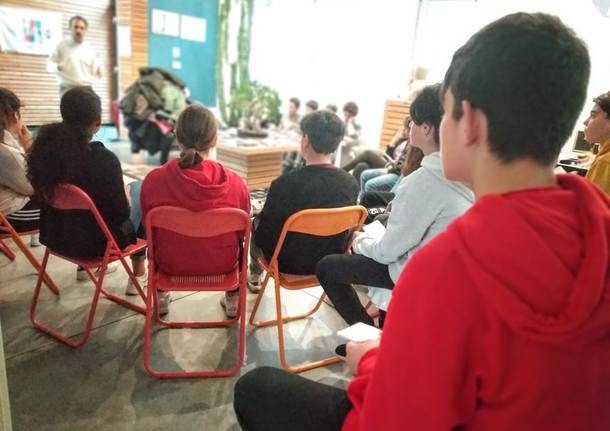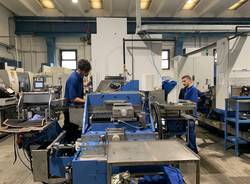For young people, socialising is vital. Now, even breaktime is “on line”
In addition to lessons and tests, the school is also thinking about socialising during “breaktimes”, and a psychologist is going to deal with the worries and anxieties of this difficult time

Schoolchildren can’t go out, see their friends, do sport, or hang out for a bit of fun and a laugh. Or even confide in, or encourage each other.
For over a month, thousands of children and young people have been living a new experience, one that is disorienting. “As a school, we’ve collected the requests of pupils and parents to have space to socialise,” explained Tatiana Galli, the headmistress of the comprehensive school in Fagnano Olona, “in addition to the lessons and homework. They have also asked for opportunities to deal with the particular situation we’re living through.”
Tomorrow, on Monday, March 30, the comprehensive school in Fagnano Olona is organising sessions for students, with a psychologist. Forty minutes a week, when they can meet a specialist and discuss together the worries and anxieties that social isolation causes.
Divided by age group, from the third grade to the eighth grade, the children will be able to speak with Dr Sara Matarese, a developmental psychologist.
“In my opinion, the isolation of children and adolescents entails some critical areas,” Dr Matarese said. “When talking with the children, it emerged that what they miss most are the moments for informal socialising: the morning walk to school with their classmates from the local neighbourhood, the chat at breaktime, practical jokes in the locker room after a football match. This might seem trivial nostalgia, but they indicate how much this isolation is in danger of depriving children of important areas of growth and experimentation. For a teenager, his own group of friends is the Sense of Life! Everything in his body, from the synapses, which are still being organised, to increasingly high hormone levels, is driving him to socialise, something that is as vital as oxygen. But even for the younger children, contact with their peers is fundamental for growth, not only of their social skills and forming their personalities, but also in the learning processes themselves.”
What are the risks?
Isolation can lead to a flattening of emotions, due to a routine that is suddenly void of structure and objectives. For example, beforehand, a boy might have been motivated to finish his homework quickly, so that he can go to basketball practice, but now the hours are all the same, and motivation needs to be found in a more abstract form, which, at this age, cannot be taken for granted.
In my opinion, these two critical areas, can be dealt with sufficiently effectively if the family and the school make an effort to deal with them, with the right organisation. It is important to maintain a balanced routine, by agreeing on precise times for getting up, washing, getting ready for school and following online lessons. When structuring lessons, it is useful to keep relational exchange, interactivity and personalisation as open as possible. In general, it is necessary to ensure that, during the day, our students have the right space for socialising, with precise rules on using social media, in accordance with age. Then, there needs to be the right space for relaxation, personal hobbies and physical exercise. Particular care, especially for the older ones, who tend to get out of control, should be paid to ensure that they maintain correct sleeping habits, otherwise there is a danger of upsetting the biorhythms, which, with growth, are already quite delicate.
However, isolation can really be dangerous, when maintaining a calm atmosphere seems an impossible mission. I am not only talking about families with serious problems of violence, psychiatric diseases or addictions, or families in conditions of socio-cultural disadvantage, where they live crowded into a small space, where there is no chance of privacy and quiet, let alone technological resources for everyone. I am also talking about families experiencing a small or big drama: economic, work, marital, health … If a family is going through a crisis, or is itself in crisis, we know that its members, more than others, need to go out, to breathe different situations, to meet other people, to put their constant brooding over a problem on stand-by for a moment. And this is especially true for children and young people, who are proverbial sponges, as they absorb the emotional atmosphere in a room. They are very good at “detoxifying”, by absorbing the positive atmospheres they find around and about, at a friend’s house, in the gym, at school … but we can easily see that, with isolation, they are denied this opportunity.
The other great danger I fear is emotional contamination. As we’ve seen, adults are already easy victims of alarmist proclamations and of the uncontrolled circulation of pseudo-scientific and fake news. This is even truer for young people, particularly young children, who do not have the cognitive structures to understand the extent of the phenomenon they are experiencing and therefore rely on the behaviour and emotions of the adults around them to understand what is happening … and unfortunately, they find many contradictions between our words and our actions, because we ourselves are often in a state of confusion.
It also happens to us adults, for example, when we are on a plane and we feel turbulence. We immediately look to see how the flight attendants react. The pilot can make all the reassuring announcements he wants, but if the flight attendants start running up and down the aisle, checking seatbelts, reminding us of how to attach the oxygen masks … we’re even more alarmed, because we immediately suspect that the crew are not telling us what the real problem is. Here, we create a breach of trust, which for a child is extremely harmful: if mum and dad tell me to stay calm and that there are no infections in my neighbourhood, why won’t they let me play with the neighbours in the yard? Why do we have to paint posters saying that everything will be all right? What is going so badly? It’s as essential as ever to protect children and young people from fake news and to give them the correct information, according to their age group, talking calmly about what is happening and what we are doing to deal with the situation in the best possible way.
In your talk, which is divided by age group, what are you going to focus on?
My intention is to give a talk that is as interactive as possible, in which we can freely share our experiences as they relate to the health emergency and to the resulting restriction measures. One of the guiding topics of the meeting will be fear in the time of the coronavirus, and my intention is to frame this phenomenon with the students, giving it the right weight: fear exists; it is an experience that unites us all, and children should be allowed to live it and express it.
Is technology a valid tool for overcoming isolation? To what extent?
Technology is proving to be a great support in managing this period of isolation. We have seen many examples of creativity in the use of social media and digital tools. For example, musical groups, with each member playing from his or her own room, putting together pieces, fitness and yoga groups via Skype … which is wonderful and life-saving! But doing dance exercises on a webcam in your room is certainly not the same as following dance steps in a gym, with your friends. We’re looking for every trick also to reach the faces, hands and bodies of our children and activate that interactive exchange that strengthens good relationships … but there are things that can’t be replaced, especially with the youngest ones, who have a very physical way of relating. For example, just think about how important the simple touch of the teacher on a shoulder is for a child that’s a bit absent-minded or demotivated; it gives them encouragement to continue writing. But even for older children, their bodies are essential for a complete relationship with the environment. Anyone who has entered a middle school corridor at breaktime knows that it is not easy to go past the clusters of children, one after the other … and not because of the lack of space in the corridor, but because there’s a strong need for physical contact: to push, to tease and hug each other. Unfortunately, technology will never be able to recreate this magical chemical mixture.
In addition to psychological counselling, the headmistress has been thinking about places in which to “chat”. “This request was made during the Students’ Council,” the headmistress explained. “So, we’ve created rendezvous, also using the ‘Zoom’ platform, where students get together to chat. These will be protected places for communication, because they’ll be under the supervision of a parent, who will ensure participants behave correctly during these ‘chatting times’.”
TAG ARTICOLO
La community di VareseNews
Loro ne fanno già parte
Ultimi commenti
lenny54 su I no vax sono tornati a colpire in provincia: imbrattati i muri della redazione di Varesenews
malauros su I no vax sono tornati a colpire in provincia: imbrattati i muri della redazione di Varesenews
Felice su I no vax sono tornati a colpire in provincia: imbrattati i muri della redazione di Varesenews
PaoloFilterfree su A Varese Salvini prova a ricucire passato e futuro della Lega, ma Bossi non c'è
axelzzz85 su A Varese Salvini prova a ricucire passato e futuro della Lega, ma Bossi non c'è
elenera su A Varese Salvini prova a ricucire passato e futuro della Lega, ma Bossi non c'è


















Accedi o registrati per commentare questo articolo.
L'email è richiesta ma non verrà mostrata ai visitatori. Il contenuto di questo commento esprime il pensiero dell'autore e non rappresenta la linea editoriale di VareseNews.it, che rimane autonoma e indipendente. I messaggi inclusi nei commenti non sono testi giornalistici, ma post inviati dai singoli lettori che possono essere automaticamente pubblicati senza filtro preventivo. I commenti che includano uno o più link a siti esterni verranno rimossi in automatico dal sistema.